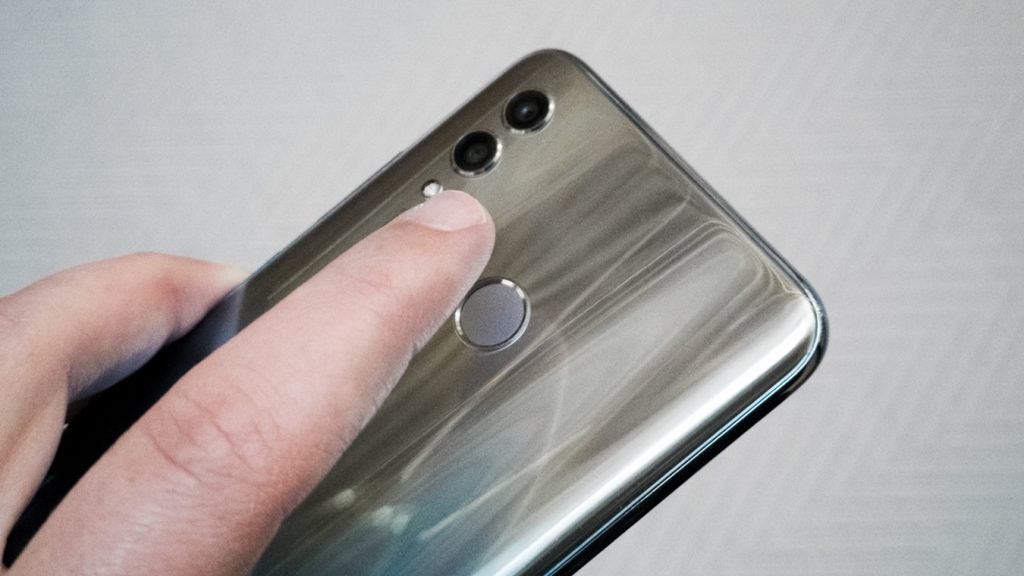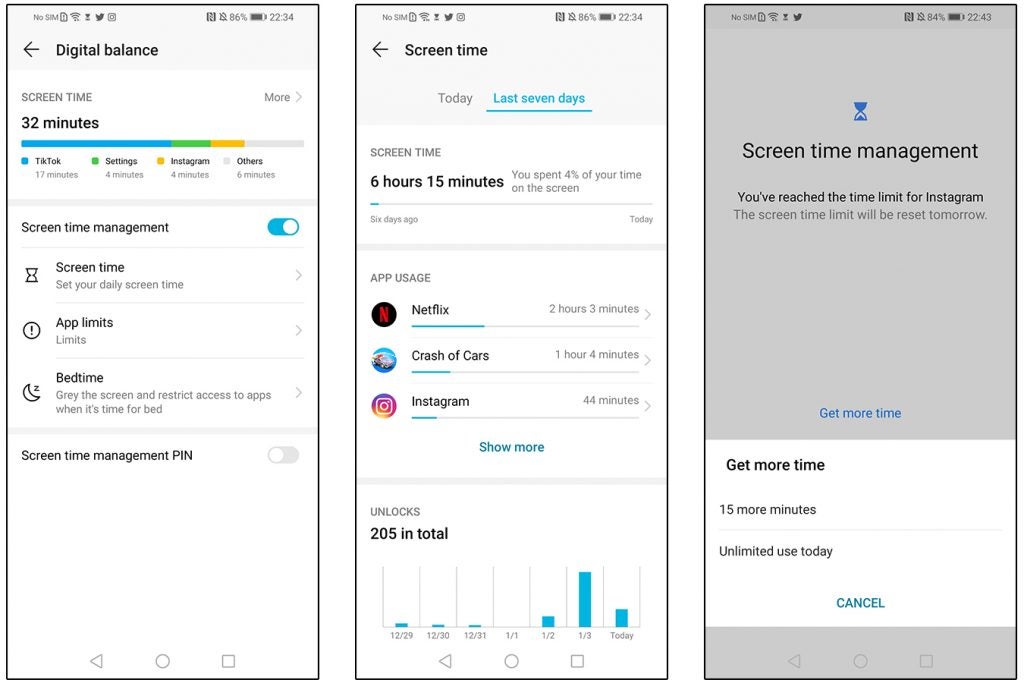Honor 10 Lite Review
Honor 10 Lite Review
Good, if a little underbaked

Verdict
As reviewed, the Honor 10 Lite feels a little underbaked but with a little tinkering before launch, this is an enticing option for under £200. Laggy performance out the box but a robust feature set mean it's still worth considering.
Pros
- Attractive design for the price
- Decent battery life
- Included case
- Feature rich
Cons
- Heavy skinned software missing key features
- Poor gaming performance (pre-GPU Turbo 2.0 update)
- Prone to fingerprints
- Plastic build
Key Specifications
- Review Price: £199.99
- Display: 6.21-inch FullView (1920x2340)
- Processor: Kirin 710 processor
- Storage: 3GB RAM, 64GB storage (microSD expandable)
- Battery: 3400mAh - 10W fast charging
- Camera: Dual 13/2-megapixel rear
- Camera 24-megapixel front-facing
- Audio: 3.5mm jack + FM radio
- OS: Android 9 Pie
What is the Honor 10 Lite?
As its name suggests, the Honor 10 Lite sits below the Honor 10 in the Huawei offshoot brand’s ever-expan. Offering some of its pricier siblings features and design traits but in a cheaper shell.
It’s also exempt from the Google ban issues you’ll see on phones like the new Huawei 30 Pro. GMS (Google Mobile Services) is alive and well here, meaning you can still access Play Store and download apps like YouTube and Gmail without trying out some kind of workaround.
Related: Best mid-range phones
Despite its humble standing, the Honor 10 Lite also serves as the follow-up to one of the company’s most popular devices of last year, its predecessor, the Honor 9 Lite.
Honor 10 Lite Screen – Punchy, for an LCD
The extended 6.21-inch Full HD+ FullView IPS LCD on the phone’s front renders the Lite one of the larger handsets out there right now.
The rounded corners of the relatively thin bezel ensure the phone boasts up-to-date styling, while the small rounded “Dewdrop” notch at the top houses the impressive 24-megapixel front-facing camera, which also allows for face unlocking.

The screen itself copes well in bright surroundings and by default pushes out punchy colours (for an LCD). Thanks to Honor’s in-depth display controls, you can calm the colour palette of the screen down easily enough; I switched from ‘Vivid’ to ‘Normal’ pretty quickly as it was a bit too harsh on the eyes after extended use.
Honor has also included manual colour temperature adjustment as well as an ‘Eye Comfort’ night mode, which warms up the display colour temperature for easier evening or low-light viewing.
It’s a perfectly capable display for enjoying media or web browsing, let down by weak contrast and viewing angles that feature noticeable brightness drop-off the moment the phone is held off-angle.
One other gripe is the absence of a one-handed mode. Practically every Huawei and Honor phone in recent memory that I’ve tested has included the option to shrink the interface down with a quick swipe across the navigation keys, but the feature is completely missing on the Honor 10 Lite. It’s an extra assistive tool that would have been welcome on a device with such a large display.
You do, at least, have the option to hide the camera notch if you don’t like the way it encroaches on the UI.
Honor 10 Lite Design – Eye-catching
The Honor 10 Lite sports an elongated display, a corner-mounted vertically-aligned dual rear camera, a centrally-positioned rear fingerprint sensor and an eye-catching body with styled reflective pattern work across its back.
At first glance, it’s a pleasing looking handset that’s in keeping with the company’s other late 2018 phones. In markets including the UK, you’ll be able to pick the Lite up in Midnight Black, Sapphire Blue or the more distinct Sky Blue that I tested. It doesn’t bring quite the same level of pearlescence or visual pop as the Phantom Blue of the original Honor 10 to the table, but it’s still nice to ogle.

Pick the phone up and you’ll immediately notice that despite presenting as glass and metal, it actually sports an all-plastic build. The back sounds a touch hollow when tapped and flexes under-finger; it feels cheaper than it looks, which is a shame in day to day use. The shiny back, along with the display, which comes with a pre-fitted screen protector, also hold onto smudges and fingerprints all too easily; more readily than glass in fact, so be prepared to buff this phone up often if you choose to ignore the included in-box case.
The phone’s hardware controls (a volume rocker and beneath that, the power key) run down the right side of its body. They feel perfectly solid, sturdy and should sit within easy reach for most users but, like the body, are hewn from plastic rather than metal, reinforcing the phone’s standing as a budget handset.

The back of the phone subtly curves away at the sides, which means it sits against your palms comfortably and while there’s a slight camera bump from the rear dual snappers, the Lite should sit stably on most flat surfaces.
There’s also a rear-facing fingerprint sensor, which is decently snappy and supports gestures so you can easily get at notifications.

The base of the phone features the increasingly uncommon but unquestionably appreciated 3.5mm headphone jack (which also facilitates the phone’s FM radio), along with a loudspeaker and, somewhat strangely, a microUSB port. I would have liked USB-C, as is now the standard for most phones at higher price points, but I’ll concede to Honor’s reasoning here. The budget-conscious target market for the Honor 10 Lite will far more likely microUSB cables lying around compared to USB-C – a standard only really utilised by newer, more expensive tech. If the same move is made on the 10 Lite’s successor, however, I’ll be disappointed.
Honor 10 Lite Performance – Kirin 710 provides decent speed
Although my Honor 10 Lite review sample wasn’t willing to play ball with the standard gamut of benchmarking apps we use to quantify the claims of a particular phone’s clout, I was able to gauge enough real-world performance behaviour to paint a clear picture of the what this handset has to offer.
Honor’s used the same Kirin 710 processor that the Honor 8X and the more premium Huawei Mate 20 Lite rely on. Having tested those other devices, it’s a decent mid-range processor with enough power for most user’s everyday smartphone needs, however, where the Honor 10 Lite is concerned, I found that its gaming prowess was lacking.

While load times were par for the course, actual gameplay ran at a decidedly sluggish clip, with a frame rate consistently below a pace that I’d consider enjoyable. Titles were still playable but it was hard to get immersed with the jerky on-screen action as it was. And forget trying to play graphically intensive titles that require fast reactions.
Honor says that the phone will receive its own build of the company’s GPU Turbo 2.0 update, which I’m hoping will fix this issue, but right now the Honor 10 Lite isn’t for serious gamers. Stick to Threes or Alto’s Odyssey, however, and it’ll do just fine.
Outside of such demanding tasks, the experience is decidedly smoother and more palatable. The Lite has little issue as you zip around the UI (user interface) and even jumping between open apps is pleasantly snappy. Don’t expect flagship-class responsiveness but don’t fret about day-to-day performance either.
Pain points that may be fixable via software updates include longer app load times than I expected and dropped frames within UI animations, such as swiping away notifications or summoning the pre-loaded SwiftKey keyboard.
Beyond on-screen performance, call quality seemed reliably clear, I had no gripes browsing on 4G and the phone’s hybrid dual-SIM functionality is appreciated (you can trade a second nanoSIM for microSD expandability up to 512GB) too.
Honor 10 Lite Software – You’ll still get Google apps here
Honor has been quick to adopt the latest Android 9.0 Pie as the underlying OS powering the 10 Lite’s user experience, on top of which it’s placed its own Emotion UI overlay. The latest 9.0.1 build of EMUI running on the Lite introduces new elements like Digital Balance – Honor’s interpretation of Android Pie’s native Digital Wellbeing feature.

Its main purpose is logging the amount of time spent within each app each day and if you so choose, you can set a limit after which a chosen app locks you out (unless you decide to forcibly extend access). Like Android’s native Digital Wellbeing, you can also pull out reports based on your usage behaviour and set a “Bedtime” mode that greys out the interface in the evenings to dissuade you from using the phone at that time.
Honor has also implemented a new screen record shortcut, with power and volume up activating screen recording, whilst power and volume down snaps a screenshot.
Beyond new functionality, the user experience feels unchanged from practically every other current-gen Huawei and Honor handset. It’s still unclear whether features like one-handed mode will arrive down the line but overall there are already a wealth of options to accommodate customisation and personalisation of both the phone’s look and feel, as well as interaction behaviour.

There are a few pre-loaded first-party apps that most people likely won’t use, such as the inbuilt Honor Store app and the HiSense image search shopping feature, but on the whole, the depth of the user experience comes from the settings menu; with tools and options to change themes, wallpapers, app icons, gesture-based “Motion Shortcuts” and more.
Despite improvements made from generation to generation, EMUI is still an unquestionable heavy skin and a distinct one at that, it won’t be to everyone’s tastes; especially those who appreciate the simplicity of stock Android or lighter takes on the OS as seen on Motorola’s, Nokia’s and OnePlus’ phones.
Related: Best Android launchers
Honor 10 Lite Camera – 24-megapixels on the front
One of the big talking points with the Honor 10 Lite is its front-facing camera. 24-megapixels means it captures a generous amount of image data and there are a wealth of pro-selfie features on-hand to augment the shooting experience further. What’s more, while it may not be as secure as the rear fingerprint sensor, the option of face unlock is both viable and surprisingly reliable for an RGB-only solution such as the one on the Lite; able to work well, even when the lights are low.

When snapping faces with the front camera, there are in-depth beauty tools and a portrait mode-style background blur feature, both of which work as promised. Image quality is good overall, albeit, with weaker contrast, more noise and less detail compared to the standard Honor 10 (and other pricier phones), but the quality gap really wasn’t as big as I’d expected.

The 10 Lite offers plenty of pixels to play with and a surprisingly effective front-facing portrait mode

As noted by the script besides the rear camera lenses, the Honor 10 Lite also comes with some AI imaging enhancement smarts. Its focus is making sure colours pop and shots are as eye-catching as possible, which it achieves by detecting the scene from one of hundreds that it’s been trained to recognise and then applying the appropriate settings accordingly.

AI scene detection: The Honor 10 Lite was able to recognise snow in this scene.

With AI switched on (below) the camera boosts colour saturation and contrast for a more pleasing outcome.

Scene detection is surprisingly good but the AI-enhanced results can be hit or miss, depending on the scene in question. I found myself snapping the same picture twice with AI both on and off to see which I preferred – not a luxury that every type of shot affords you.

The above and below shots showed little difference with AI on and off. These are both without AI enabled.


Generally, image quality is good in natural light. The dual 13/2-megapixel sensor setup on this Honor isn’t going to win any awards but it’s well-equipped to give similarly-priced smartphone snappers a run for their money.

Night mode (below) is a necessity in low light but the results still aren’t amazing

In low light, the standard shooting mode is an absolute no-go. Despite the main 13-megapixel sensor’s suitably-wide f/1.8 aperture, the images it’s capable of capturing aren’t really usable, plagued by blur and a severe loss of fine detail. Thankfully, Honor’s included a Night mode, which is surprisingly effective.
While Night mode (above) makes low light shooting on a £200 phone usable, it still has a ways to go when compared to a normal low light shot (i.e. not Night Sight) on the likes of a flagship like the Google Pixel 3.
![]()
Noise and grain unquestionably go up when shooting in this mode but so does detail – it doesn’t come close to what the likes of the Google Pixel 3‘s Night Sight or the Huawei Mate 20 Pro‘s night mode are capable of but it does at least make otherwise pointless shots worthwhile.
Honor 10 Lite Battery life – One of its most appealing assets
The 8X’s large battery is one of its most appealing assets and the same is true of the Honor 10 Lite. Its less demanding internals and a sizeable 3400mAh battery make for a capable combination.
You can expect between one and two days of use, with the former more likely if you’re a media junkie like I am. With gaming, streaming and the like I ended the day on low power (below 20% charge) but that included over 4.5 hours of screen-on time and almost two hours worth of Netflix playback.

Gaming and media streaming (Alto’s Odyssey, Crash of Cars and Netflix) each sapped around 8% to 9% of the battery’s power after a 30-minute stint but I have suspicions that the cold weather that the phone was subjected to on my commute may have factored into these figures as well.
As for recharging, the phone does come with a 10W fast charger in-box, but with a battery that size to refill, the Honor 10 Lite still took around two hours to fully replenish.
Should you buy the the Honor 10 Lite?
While the Honor 10 Lite has its issues, here’s hoping that most of them will be resolved before the phone hits store shelves. At £199.99 it’s a perfectly capable device with a pleasingly eye-catching aesthetic and a rich feature set.
The increasingly affordable Moto G6 Plus makes for a worthwhile alternative if you want an even larger battery, but nobody squeezes as much functionality into their phones as Honor (and Huawei).
The Honor 10 Lite does a decent job of emulating its more premium sibling and if it weren’t for some wavering performance concerns and notable weak points with the camera and the build, it’d be easier to recommend.
Related: Best cheap phones
Verdict
Even so, at under £200, there’s a lot of phone on the table here and with carriers like Three UK picking it up as well, it’s certainly an approachable budget offering worth considering.
How we test phones
We test every mobile phone we review thoroughly. We use industry standard tests to compare features properly and we use the phone as our main device over the review period. We’ll always tell you what we find and we never, ever, accept money to review a product.


